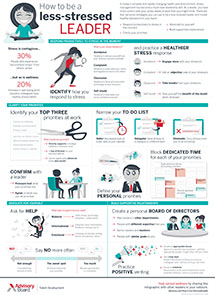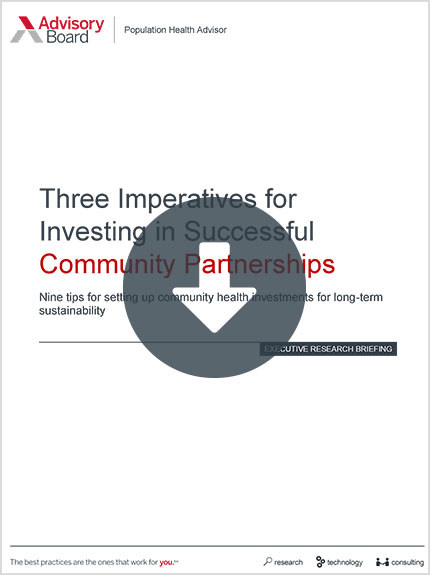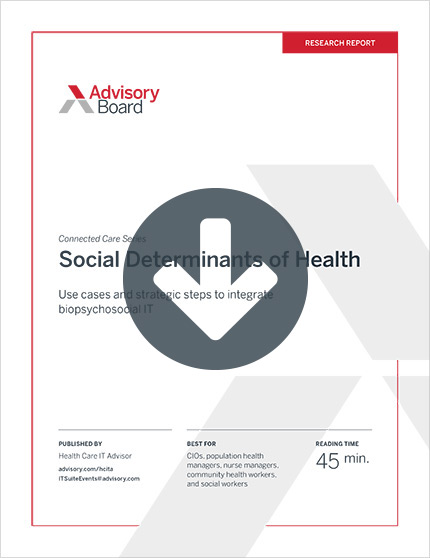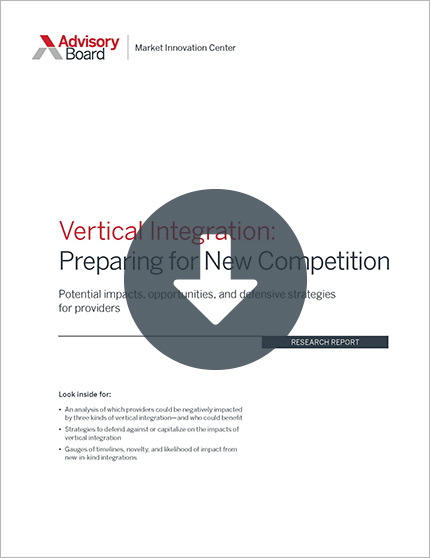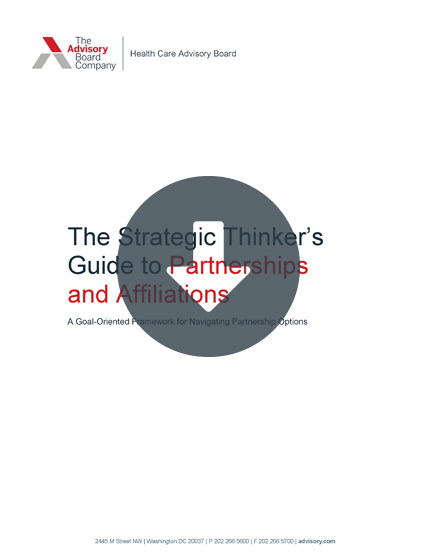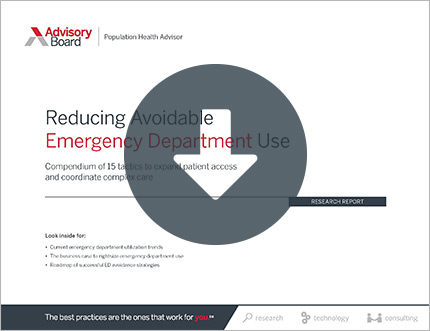Auto logout in seconds.
Continue LogoutWelcome to the "Lessons from the C-suite" series, featuring Advisory Board President Eric Larsen's conversations with the most influential leaders in health care.
In this edition, Barclay Berdan, CEO of Texas Health Resources talks about about the "unprecedented challenge" he faced just a few months into the job, why he won't call THR a "hospital system," and how he helped establish the world's largest Blue Zones community—in Fort Worth.
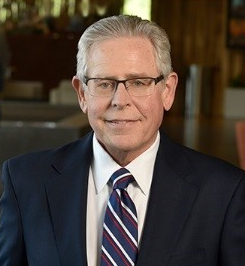
Barclay Berdan, CEO of Texas Health Resources
From budding oceanographer to health system leader
Question: Barclay, before we dig in on the technicalities of running one of the nation's largest faith-based nonprofit health systems, let's talk about how you wound up in the CEO seat in the first place. While I was doing my background research for our conversation, I not only learned about the white Pontiac Firebird you drove during your first run as a hospital leader—and we'll talk about that in a moment—but I also learned you've had this lifelong interest in science and oceanography. So why am I not talking to Barclay Berdan, esteemed marine biologist, instead of Barclay Berdan, CEO of Texas Health Resources (THR)?
Barclay Berdan: You know, I never envisioned myself in business; I was always a science guy. I've had a subscription to National Geographic since 1963, and I got dive-certified at a local YMCA when I was in high school. So I ended up as a biology major at Texas Christian University (TCU), a school that, interestingly, offered a marine biology degree even though it was 600 miles from any big body of water.
But I eventually realized that I wasn't interested in any of the professional options available to me with a BS. And at the time, I had a roommate whose uncle was a hospital administrator and who was trying to convince him to get a master's in health administration. I'd never heard of that field before—I'd almost never been in a hospital before—but I started looking at the material my roommate's uncle sent him, and I realized it could be an intriguing mix of science but also something where you could actually support yourself. That was what really turned me in that direction.
Q: But then you ended up going to the University of Chicago for an MBA—not an MHA. What made you commit to health administration as a career?
Berdan: While I was at Chicago, I worked part-time as an evening administrator at a hospital in Jackson Park. And that's where I really learned about the hospital industry. I mean, if you want to know what goes on in a hospital, hang around after dark in an urban hospital in the middle of a medically underserved area.
So I learned a lot, and—in my second year of grad school—I was asked to transport the program to Northwestern Memorial Hospital, and I did.
At the end of my graduate study, I had experience at a very poor urban hospital and a very rich academic medical center, and I wasn't sure I liked either option. So I ended up going with the for-profit industry, over at American Medical International. I hadn't worked for them long when I got a call, asking if I'd go run this 133- bed hospital in Newport, Arkansas, a very small, rural community.
Q: So you're in your late 20s, helming a 133-bed hospital in this small town. What was that like?
Berdan: You know, Eric, I was young—and as you already had some fun pointing out, I drove a very recognizable white Pontiac Firebird, so everybody was watching to see where I was all the time. If you really wanted to go out and let your hair down, you had to drive to Memphis or Little Rock or somewhere like that, two or three hours away. But I learned a lot, and I stayed with AMI—in Arkansas and, later, in Texas—for several years before I joined Harris Methodist Health System in 1986.
And of course, in 1997, Harris Methodist merged with Presbyterian Health Resources, and that's how we created THR.
Re-ignite the growth engine: 3-part report series
Navigating the shift from 'sick care' to health care
Q: Let's jump forward in time from 1997 to 2019. You've essentially been with THR or its predecessors for 30 years. In that time, it's become a market leading health system: 29 hospitals owned, managed, operated; $4.8 billion in annual revenue, give or take; 350 sites of care; and 6,000 doctors with credentials. Given all of this system growth and evolution, how would you describe THR today?
Berdan: We oftentimes get introduced either directly or indirectly as a hospital system. That's understandable, because our legacy business is running acute-care hospitals. But over the last six or eight years, we've redefined the system as a health system—not a hospital system.
A health system is an organization that more fully lives the mission to improve the health of the people in the communities we serve. By comparison, hospitals are generally where we take care of sick and injured people. We may be restoring their health to some degree, but we're not really improving their health. It's sick care, not health care.
Q: That's an important distinction, and I think it draws attention to the essentially unfunded mandate for the health care industry to address social determinants of health. The research would suggest it's hard for a hospital-centric system to create the necessary margin to subsidize these social determinants.
Berdan: I agree with you—I think you're only able to do it if you are able to generate sufficient margin. We've been fortunate to be able to put cash away, and we have a great investment committee that's done a good job of growing and preserving that, so we've been able to invest in these efforts. For instance, we had to put $8 to $10 million a year into our Blue Zones work.
But we have to be cautious; we can't make a lot of mistakes, and we recognized that we didn't have the expertise we needed. Frankly, that's why we do partnerships. It's why we did the partnership with Surgical Care Affiliates (SCA) [Editor's note: SCA is now owned by Optum], because we recognized after trying several times that we didn't have the competencies for ambulatory surgery. So you have to acknowledge your limitations, know that you're going to make mistakes along the way, and then apply those learnings as you go forward.
Q: I want to circle back on something you just mentioned in passing, the Blue Zones initiative. In my view, that's one of the most progressive and exciting initiatives THR has undertaken in recent years. Fort Worth was recently certified as a Blue Zones Community, making it the largest such community in the country—and, technically, in the world. Would you give some background on the initiative? What is it? How did you launch it?
Berdan: Blue Zones stems from research that Dan Buettner did for National Geographic, where he went around the world to find places where people live longer, better lives. From that work, he identified a set of principles common among the Blue Zones—he called them the Power 9—that people could apply to their lives and communities to live longer, better lives. We first heard about it when Healthways—a company Dan had worked with, which has since been sold to Sharecare—brought in some folks to talk about it at our leadership retreats.
Everyone loved the idea, but we never could quite figure out what to do with it until I had a meeting with Fort Worth Mayor Betsy Price, who's always been very focused on health and well-being. Together, we invited the Blue Zones folks to assess Fort Worth. They hadn't tackled an area this big before, but they said they'd be willing to do it because they liked the leadership and what had been going on.
Five years later, our team has about 40 or so folks working in every sector—schools, grocery stores, restaurants, work sites, and at the policy level too—and, like you said, we just got our certification as a Blue Zones Community.
Q: What does it look like in practice? How did you build it out, given the sheer size of the Fort Worth area?
Berdan: Basically, it's a set of tools. So an individual can make a pledge to make two or three life changes selected from this curated list of options, such as using a smaller dinner plate or picking a healthier side when you go out to eat. For Fort Worth, we also added faith communities—that wasn't on the existing Blue Zones list, but we included it because we felt it was important for Fort Worth.
Now, we had teams of leaders who worked with a larger team of volunteers, and we ended up impacting about 25% of the region's population—that's about 200,000 or 225,000 people. In one way or another, either through a work site or a grocery store or a school, more people are eating fruits and vegetables, more people are exercising, more people are walking naturally. And it's hard to measure outcomes on health and well-being, but Fort Worth has in just four years moved from the bottom of the barrel on Gallup-Sharecare's well-being poll—185 out of 190 or something like that—all the way up to 58. And Gallup tells us we are bucking the trend. Nationwide well-being scores are declining.
Q: Your experience here is instructive, and the insights are applicable to other parts of the industry—we're seeing a lot of divergent ways health systems are experimenting in addressing social determinants. How are you thinking about expanding (and funding) this initiative more broadly across THR?
Berdan: A couple years ago, when we streamlined the hospital board structures so that they go through the THR Board of Trustees via a mirror board structure, we thought it would be the perfect time to sort of "reactivate" our volunteer leadership away from a hospital-centric approach and toward social determinants. So we took all our hospitals' individual community health improvement initiatives and created a committee—the Community Impact Board, which has five leadership sub-councils—that reports directly to the THR board.
Initially, we wanted everyone to spend the first year learning about social determinants and their communities' health needs. Once the learning period ended, the five councils would make pitches for investing in social determinants in their communities in front of the Community Impact Board, essentially competing in a Shark Tank-like way for $5 million that THR would pledge for that purpose. But after the councils made their pitches, I actually ended up increasing the pot to give each council what it asked for—and that's just the first cycle, right? I've told them, "Learn that in a first cycle. Then I'm going to ask my foundation to match that $5 million, so you'll actually have $10 million." And in the second cycle, if they can match that, then I'll put in $10 million and ask the foundation to come up with another $10 million. So that will increase in a stair-step way our investment in working on specific social determinants.
Q: And funders are responsive to these initiatives?
Berdan: You know, it's interesting, because as part of the process, we talked to funders about their interests, and we're seeing a somewhat decreased interest in philanthropy for bricks-and-mortar. It's still out there—I have a campaign for a new tower—but we're seeing newer foundations or individuals shift their focus to funding a different kind of community impact. So now I'm actually trying to sort the skills in our foundation staff so we can do a better job of accessing some of that funding.
Trial by fire
Q: I'd like to shift course a bit and ask about your first few months in seat. Because after you became CEO on September 1, 2014, you faced an unprecedented challenge: THR was—and still is—the only organization that actually diagnosed a walk-in patient with Ebola in the United States. As you think back on that time in the THR story—now a few years behind you—what are your reflections on the experience?
Berdan: Well, we missed the diagnosis before we caught it; the patient wasn't diagnosed until he came back the second time. When I think about our reaction to the situation, there are two parts: First, the system—for whatever reason—selected me, an internal candidate, to succeed Doug Hawthorne rather than an external candidate, who would have had basically no knowledge of the system. I was a known entity; people trusted me, and I had a lot of knowledge about the system. I often wonder what would have happened if that had not been the case.
Second, you have to make the decision upfront: Is this something you delegate, or do you drop everything else and take this on yourself? I was in DC when this happened, but I got on the first flight back and basically camped outside of Texas Health Dallas Campus for the better part of a month.
Q: What would you advise other systems facing a situation that requires the same sort of nuanced, immediate response? The key lessons learned?
Berdan: You need to pay very close attention to what you say and who says it. I think we created some problems when we were trying to be upfront about managing the challenges that arose—it was interpreted as us blaming certain people or programs. So the lesson learned would be that if you don't have anything to say, don't say it, because it just snowballs on you.
And I remember on several occasions having to decide who to put in front of the media or Congress. A lot of people said I had to do it because I was the CEO, but I didn't think so—it was important that we had a white coat, a credible medical professional—standing up there, and that was the right move. But one of the best decisions we made was, several weeks into it, taking something we'd done internally—a video compilation of nurses talking about what they liked about the hospital—and made it external; we put a camera in the yard, and people would just come up and talk about the hospital. That was very powerful. It brought humanity into the discourse.
Q: And there was the "60 Minutes" coverage.
Berdan: When a nurse comes to you and says, "I've been talking to '60 Minutes'," you have a choice to make, and we made the right choice. We didn't say, "You're not supposed to talk to the media. You're fired." We said, "OK, let's talk about that."
Their stories were heartfelt and personal. They were able to provide closure to what had become a very scary story for many people in the Dallas-Fort Worth area and the country. They, like all our front-line caregivers during that time, were unsung heroes.
Texas Health Aetna
Q: Let me pivot back to 2019 and talk about another key strategic priority for THR—your approach to vertical integration. Overall, there are only a handful of consistently profitable integrated payer-providers—Intermountain, Geisinger, UPMC, Kaiser, etc.—and the average age of their health plans is 19 years; in other words, the successful ones have been at it awhile. So your experience in launching a new health plan with Aetna, Texas Health Aetna, in 2016 might be instructive to others. Why did you decide to partner versus launching a de novo health plan?
Berdan: One of the advantages of being a gray-hair in this marketplace is that I was around when the Harris Methodist System built its own health plan in the early or mid-90s, just before we merged with Presbyterian. The plan had roughly a 450,000-member HMO, mostly commercial. And the health plan worked well for the employers, but when we got into the time in the insurance cycle when premiums were being driven down, after you've run out of room to take your bricks-and-mortar down, then you have to turn to the doctors with a rate cut. It was rough.
So not too long after that, when we came together as THR, my predecessor, Doug Hawthorne, decided to sell the plan to Pacific Care. He said it wasn't good for our relationship with our physicians, and he was concerned about the cash reserves we would need to sustain ourselves in the future.
And my takeaway from that experience was that we had tried to do it all alone, so—when we decided we may want to get back into the business—one quick decision was that we weren't going to do it on our own again. We needed a partner, someone who knows the business. And we've made that same decision over and over again; we need a partner who brings skills and abilities that are stronger, easier, more quickly deployed than we can do on our own. That approach has been the key change enabling us to avoid the same challenges we had before.
Q: After you decided to partner, what drew you to this particular collaborative structure and product?
Berdan: The organization had two trains of thought going into this. One was that we needed something to compete with Baylor Scott & White, since they'd just merged. The second—which I was more interested in—was that we needed to focus on innovation. We needed to work on products that offer more value to compete not just with Baylor Scott & White, but with other organizations too. So we went through a process to assess probably about 40 different kinds of opportunities for partners and plans before we settled on a 50-50 joint venture with Aetna.
Now, we're still learning a lot in this process, but we've been able to create some really innovative products together. For example, our ED physicians worked with a company to develop this asynchronous texting product to curb ED readmissions that's become—according to the brokers and the employers—the most popular private attribute of our plan. And we've just done a partnership with DispatchHealth to deliver urgent care at home or work and, again, keep people out of the ED.
Q: What can you share in terms of the numbers you've signed up or where you want to go?
Berdan: Well, the nature of our relationship is that we have about 100,000 lives that Aetna imported in. Not all of our employees have been moved into the joint-venture.
Q: Why not?
Berdan: We've been the top health care organization in terms of being a great place to work, which means I have a very engaged group of employees, so I wasn't willing to throw them into an untested joint venture. We made it a slice option, and about 10% chose it. And this cycle, actually, we experimented with a second Aetna plan, a high-deductible health plan, and an even smaller slice of folks picked that one. Along the way, we've begun to gain important insights regarding what drives consumers' decisions when choosing health plans.
Q: And when you look at the plan's progress so far, is this a success?
Berdan: We'll have to see how that goes. We had about as many ins as we had outs in the plan; it didn't grow dramatically. But you know, our first sale—the Grand Prairie Independent School District—just renewed, so this sales cycle is the cycle where we've finally been able to get our feet under us and move. As we fully integrate all of the components of care into a single, full continuum, it introduces new constructs for purchasing insurance and sharing value in the market. We believe these strategies are more sustainable in the long-term, but it's challenging the bigger players in the payer market who are entrenched in their traditional (and usually shorter-term) strategies. We will need to show that we are nimble enough and smart enough to win in this arena.
Partnership and growth
Q: I think one of the most important competencies of a health system CEO these days is figuring out how to build partnerships that work for all parties involved. So I'm interested in your perspective, Barclay, because you've architected a number of different partnerships—co-owned hospitals with Adventist, a partnership with Adeptus and 27 freestanding EDs, Aetna, SCA, and more—rather than following a more traditional merger-and-acquisition growth plan. What's your philosophy here?
Berdan: I've observed that in mergers and acquisitions, folks many times will verbalize commitment, but they leave a big backdoor—if things don't work out, they want to be able to leave quickly. That's why I think a lot of mergers that are happening now may not work over time: because when times get tough, it's too easy to take the backdoor.
But in a partnership, you're basically forced to deal with the issues up front. Because when we're looking to work with somebody, we're really looking for someone who thinks about the world like we do, someone with whom we can make two plus two equal more than four. It feels harder up front, because you're actually discovering, dealing, managing, and sometimes that's a lot more difficult than when someone is in control and is just making the decisions. But it either builds a stronger relationship over time or it doesn't—and if it doesn't, that might make you say, "OK, let's end the partnership."
Q: Have you had an experience like that?
Berdan: We've really had only one of those so far, and that's with Adeptus, whom we worked with on satellite EDs.
We put in a relatively small capital investment in that, and as we considered deepening the relationship, I really struggled with whether to do it. EDs provide high-cost care, which we're trying to avoid—but at the same time, are we better off being able to provide in-network access points for Medicare patients? And from a brand point of view, it gave us more access points, many in areas where we didn't necessarily have a visible access point.
But ultimately, I decided to exit that relationship at the beginning of 2019. They wanted us to assume the leases on the property, which would shift a huge amount of the risk to us. And if we were going to go that far in integrating, we were going to have to convert them to Epic, which is an expensive resource consumption.
Q: I'm curious for your perspective on freestanding EDs more broadly. These facilities have proliferated, especially in Texas and the states where they're unregulated, but—like you said—they're very high-cost. When you think about total cost of care, do you see a place in that ecosystem for freestanding EDs independent of the Adeptus relationship?
Berdan: Before we did the Adeptus deal, we had three satellite EDs associated with our nonprofit hospitals. At the time, each one was part of an integrated health campus; it was a 24-hour freestanding ED, plus physician offices, a lab, physical therapy, radiology, and a fitness center as a people-draw.
So these were never just EDs; they were basically outpatient departments built on property where we could expand them later if we wanted to. And we were judicious in using those; they all went in markets where there weren't a lot of services. It was more careful than just coming into the middle of the metroplex and saying, "We don't have any access points in this little area, so let's stick an ED there."
So we'll probably continue on a slow pace when it's appropriate to add those. That could be a part of our market strategy, to use these health campuses and do that, but not to just spread them all over the metroplex.
Q: Let's talk about Southwestern Health Resources (SWHR), the clinical integrated network (CIN) you launched with UT Southwestern. Even though we've seen CINs mushroom around the country, there's also been a fair amount of disillusionment with them. So there's a lot of curiosity about SWHR, because by all measures, it's been a success. Can you give us the origin story here?
Berdan: We've had this longstanding relationship with UT Southwestern since the 1960s, but a few years ago, when the UT system recognized that the industry was undergoing a shift toward value, they realized that they would either have to build their own network of hospitals and services—which is very capital-intensive—or partner with somebody.
Meanwhile, we'd been looking at expanding into education and research, because even though we're the largest health system in North Texas, we have only one residency program, which hosts a total of 24 spots in internal medicine at Texas Health Dallas.
So all those things together made us think about how we could collaborate.
Q: And what does the risk breakdown look like now?
Berdan: It's been a learning process, with really only upside risk where we decided to concentrate on value-based programs from the federal government. In the first three years, SWHR generated about $75 million in MSSP savings. Then in 2017, we switched to Next Gen, which is upside-downside—just 15%, which doesn't sound like much, but when you actually count the patients in the premium, it's a big number. But we've done very well there; earning the top spot in CMS' rankings, generating $30 million in savings and scoring 100% on our quality reporting rating.
Now, the entire CIN is moving into MA with United on January 1st. And we've also signed a three-party agreement with United and WellMed to provide the administrative services for that population.
Gratitude and wrapping up
Q: Barclay, as we wrap up, and as you reflect back on your career, I'd be interested in your answers to two things. First, with all you've got going on at THR, what are you most passionate about right now?
Berdan: Right now, I'm most passionate about our focus on learning about consumer behavior, because behaviors are really what drive health and well-being. It's not what the surgeon does or the nurse does. It' about nudging people to make healthy choices every day, which is really the whole point of Blue Zones.
Q: And second, as you think back sort of retrospectively, what are you most grateful for?
Berdan: Two things: I'm grateful to the THR board for having confidence and faith in me as a leader, and I'm grateful for every single one of the folks who works for us to deliver such great care, create the great outcomes and the great reputation that we have. It's just a privilege to sit in this chair for a brief period of time and have a leadership role with the organization.
Subscribe to At the Helm
To get more of our top insights for CEOs and other C-suite executives, make sure you're subscribed to the ""At the Helm"" blog.
Get more lessons from the C-suite
Check out Eric's recent must-read interviews with top hospital and health system leaders:
'A little bit of a pirate': How Kelby Krabbenhoft built a $6B system—and where he's taking Sanford next
Kelby Krabbenhoft, president and CEO of Sanford Health, talks about the unprecedented CEO-philanthropist partnership behind Sanford's rapid growth, why a successful leader needs to be ""a little bit of a pirate, and the merger that will make Sanford a nearly $6 billion health system. Read our interview with Kelby.
Marc Harrison promised to turn Intermountain into a 'Tesla.' He wasn't kidding.
Marc Harrison, president and CEO of Intermountain Healthcare, talks about Intermountain's recently announced strategic reorganization, previews the launch of a ""virtual hospital"" to better serve rural communities, and shares the surprising worry that keeps him up at night. Read our interview with Marc.
From the seminary to the C-suite: How IU Health CEO Dennis Murphy is redefining the AMC
Dennis Murphy, president and CEO of IU Health, talks about his ""Forrest Gump"" journey from the seminary to the C-suite; IU Health's planned consolidation of two century-old, iconic hospitals; and the key skill every leader—and mentor—needs to succeed. Read our interview with Dennis.
"
Don't miss out on the latest Advisory Board insights
Create your free account to access 1 resource, including the latest research and webinars.
Want access without creating an account?
You have 1 free members-only resource remaining this month.
1 free members-only resources remaining
1 free members-only resources remaining
You've reached your limit of free insights
Become a member to access all of Advisory Board's resources, events, and experts
Never miss out on the latest innovative health care content tailored to you.
Benefits include:
You've reached your limit of free insights
Become a member to access all of Advisory Board's resources, events, and experts
Never miss out on the latest innovative health care content tailored to you.
Benefits include:
This content is available through your Curated Research partnership with Advisory Board. Click on ‘view this resource’ to read the full piece
Email ask@advisory.com to learn more
Click on ‘Become a Member’ to learn about the benefits of a Full-Access partnership with Advisory Board
Never miss out on the latest innovative health care content tailored to you.
Benefits Include:
This is for members only. Learn more.
Click on ‘Become a Member’ to learn about the benefits of a Full-Access partnership with Advisory Board
Never miss out on the latest innovative health care content tailored to you.
